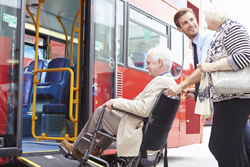Senior citizen mobility
In coming decades, the proportion of people aged 65+ will increase by nearly 30%, while the 80+ group will increase 12%. Older people have special requirements, which a future transportation system will have to plan for. Options include improved integration of all transportation modes, special licences, and greater emphasis on walking and cycling. The EU-funded 'Growing older, staying mobile: The transport needs of an ageing society' (GOAL)(opens in new window) project ran for 2 years to September 2013. The project aimed to summarise current knowledge and identify research gaps, leading ultimately to an action plan addressing the transportation needs of an older population. Researchers characterised five very different types of contemporary older people, factoring in health, social connectivity and activity. Each profile type has different transportation needs and issues in terms of driving, public transportation, cycling and walking. Based on discussions with experts, GOAL projected how the five groups will differ between now and 2030–2050. GOAL concluded that driving is the preferred mode of transportation for older people. Additionally, while senior citizens cannot be considered high-risk as a group, they do show a consistently higher likelihood of being injured in car collisions. It was also found that age-based driver screening typically produces negative consequences for older people rather than safety benefits for other road users. Thus, the study recommended alternatives such as restricted licenses. The project produced a similar analysis of the needs of older people in terms of walking, cycling and public transportation. Key ideas were that walking and cycling are very beneficial for older people, and these three modes should be made safer and more integrated. Project partners produced an action plan, which identifies seven areas for further research. These will investigate: walking/cycling behaviour, and identifying motivators for such; transition from driving to other modes; accessibility and technology measures; and travel information requirements. Lastly, the plan will investigate developing screening/assessment tools. The legacy of GOAL will be safer, happier and more active older people in the future.The high cost of healthcare of an ageing population, particularly if inactive, may well be reduced as a result.



